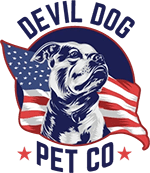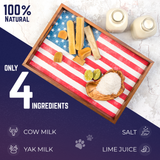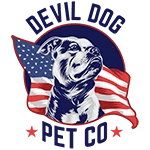Key Takeaways
- A bully stick is made from 100% beef pizzle, which is the penis of a bull.
- The beef pizzle is cleaned, stretched, and slow-baked to create the bully stick.
- Bully sticks contain no fillers or mystery ingredients.
- The product is a single-ingredient muscle tissue processed into a safe, digestible chew.
- Transparency about bully stick ingredients is important for responsible dog owners.
Table of Contents
- The Bully Stick Creation Process, From Ranch to Chew
- Bully Stick Nutrition: What's Inside, and Why You Should Care
- Safety and Health Benefits, Why Responsible Owners Choose Bully Sticks
- Bully Stick Varieties, Choosing the Right Fit for Your Dog
- Bully Stick vs. Other Chews, Is "Single-Ingredient" Superior?
- Practical Guide, How to Safely Use and Store Bully Sticks
- Troubleshooting, Common Problems and Solutions
- Responsible Chewing, How Devil Dog Pet Co. Does Bully Sticks Different
- Final Word, Extreme Leadership in Chew Selection
What Is a Bully Stick Made Of? The Unfiltered Truth Every Owner Deserves
A bully stick is made from 100% beef pizzle, the cleaned, stretched, and slow-baked penis of a bull. No fillers, no mystery ingredients, just single-ingredient muscle tissue that's been processed into a safe, digestible chew. This straightforward answer cuts through marketing fluff because responsible dog owners deserve transparency about what is bully stick made of before handing it to their pup. Shop all bully stick products to ensure you're getting the highest quality treats for your dog.
The term "pizzle" comes from old English, referring to the male reproductive organ. Modern manufacturers use this terminology for accuracy and tradition. Unlike multi-ingredient treats loaded with preservatives, bully sticks rely on heat and time to transform raw muscle into a protein-rich chew that breaks down like regular food in your dog's digestive system. Explore our full range of bully sticks for options that suit every breed and chewing style.
For more in-depth information on the benefits and safety of bully sticks, check out this comprehensive guide on bully sticks for dogs and their safety.
The Bully Stick Creation Process, From Ranch to Chew
Quality bully sticks start with grass-fed, free-range cattle raised without hormones or antibiotics. Sourcing matters because what goes into the animal directly impacts the nutritional value and safety of the final chew. Ethical sourcing also ensures traceability, you know exactly where your dog's treat originated.
The manufacturing process follows strict USDA protocols. Raw pizzles undergo manual trimming to remove excess fat and tissue, followed by thorough sanitization through multiple water rinses. Processors then shape the muscle into straight, braided, or spiral configurations before the critical slow-roasting phase begins. Find braided and spiral bully sticks here for dogs who need extra challenge and variety.
Slow-baking at 160-180°F for 24+ hours dehydrates the muscle to below 10% moisture content. This extended heat treatment eliminates pathogens while preserving protein structure and digestibility. No chemical bleaching or artificial coloring occurs, the natural tan color comes from the Maillard reaction during baking. Final inspection checks thickness, texture, and cleanliness before packaging for a 36-month shelf life when stored dry.
Bully Stick Nutrition: What's Inside, and Why You Should Care

Bully sticks pack approximately 80% protein by dry weight, delivering a complete amino acid profile essential for muscle development, skin health, and immune function. A typical 6-inch stick contains 88-90 calories with only 3-4% fat content, making it a lean protein source that won't derail your dog's diet when portioned correctly.
The muscle tissue provides trace amounts of zinc for coat health, iron for oxygen transport, and B vitamins for energy metabolism. Unlike rawhide or synthetic chews, bully sticks offer genuine nutritional value while satisfying your dog's chewing instincts. The key is treating them as part of your dog's daily treat allowance, veterinarians recommend limiting treats to 10% of total daily calories. For more details on the nutritional value and comparisons, read our blog on whether bully sticks are good for dogs.
| Chew Type | Protein Content | Digestibility | Calories (6" stick) | Processing |
|---|---|---|---|---|
| Bully Stick | ~80% | Fully digestible | 88-90 | Heat only |
| Rawhide | ~85% | Poorly digestible | 95-110 | Chemical treatment |
| Yak Chew | ~60% | Fully digestible | 105-120 | Smoke & sun-dry |
| Antler | ~45% | Non-digestible | 0-5 | Natural shedding |
Safety and Health Benefits, Why Responsible Owners Choose Bully Sticks
Bully sticks promote dental health through mechanical action, as dogs chew, fibrous strands fray and scrape plaque from tooth surfaces while stimulating saliva production. This natural cleaning effect surpasses synthetic toys because the muscle fibers conform to tooth contours, reaching areas brushes might miss. Unlike bones that can splinter or rawhide that forms choking hazards, properly sized bully sticks wear down predictably.
Mental stimulation ranks equally important. Extended chewing releases endorphins, creating a calming effect that redirects destructive behaviors like furniture gnawing or excessive barking. For anxious or high-drive dogs, a quality bully stick provides constructive outlet for natural chewing instincts while building jaw strength and coordination.
Safety protocols remain non-negotiable. Always supervise chewing sessions and remove the stick when it shrinks to less than 2 inches, small pieces pose choking risks even though they're digestible. Use bully stick holders for the final few inches to maximize value while maintaining safety. For puppies, introduce bully sticks around 10-12 weeks with brief, monitored sessions, sizing up as their jaws mature and adult teeth emerge.
Bully Stick Varieties, Choosing the Right Fit for Your Dog
Straight bully sticks represent the classic option, single pizzle stretched and baked into a uniform cylinder. These work best for moderate chewers who gnaw methodically rather than attacking aggressively. Braided varieties twist three pizzles together, creating increased surface area and density that extends chew time by 60-120% compared to straight sticks. The braided texture also provides better grip for dogs with arthritis or coordination challenges.
Curly and spiral shapes maximize surface contact while the natural curves create multiple grip points. These configurations often last longer than straight sticks because dogs must work around the bends rather than chomping straight through. Odor-free options undergo additional washing and extended baking to reduce the natural beef scent, ideal for households sensitive to smell but wanting the nutritional benefits of what is bully stick made of. Browse odor-free bully sticks and specialty shapes for sensitive households or picky chewers.
| Stick Type | Best For | Durability | Grip Factor | Odor Level |
|---|---|---|---|---|
| Straight | Moderate chewers | Standard | Basic | Natural |
| Braided | Power chewers | Extended | Enhanced | Natural |
| Curly/Spiral | All dogs | Above average | Superior | Natural |
| Odor-Free | Indoor/sensitive households | Standard | Basic | Minimal |
Size selection follows a simple safety rule: the stick should never fit entirely in your dog's mouth. Toy breeds need 6-inch Standard sticks, while larger dogs require 12-inch Jumbo versions. Aggressive chewers benefit from braided Monster sizes that provide maximum challenge and longevity. Rotate between shapes to assess your dog's chewing style and prevent boredom. For more tips on choosing the right bully stick, see our guide to durable braided bully sticks for aggressive chewers.
Bully Stick vs. Other Chews, Is "Single-Ingredient" Superior?

Digestibility separates bully sticks from alternatives like rawhide, which undergoes chemical processing that creates poorly digestible strips prone to causing blockages. Bully sticks break down completely in the digestive tract because they're composed of natural muscle tissue. Antlers offer superior longevity for marathon chewing but provide zero digestible nutrition. Yak cheese chews fall between these extremes, fully edible like bully sticks but harder and longer-lasting due to their dense, dried composition.
Safety profiles vary dramatically. Rawhide poses the highest choking and blockage risks due to its tendency to form gummy masses when wet. Beef jerky designed for humans contains dangerous spices, excessive sodium, and preservatives toxic to dogs. Understanding what is bully stick made of reveals why single-ingredient processing creates inherently safer chews, no chemical treatments, artificial additives, or mystery components. For a scientific perspective on pet treat safety, review this peer-reviewed study on pet treat safety and risks.
Cost-per-chewing-hour calculations favor different options based on your dog's intensity. Antlers deliver the best value for power chewers who might demolish a bully stick in 20 minutes but gnaw an antler for weeks. Moderate chewers often find bully sticks the sweet spot, lasting 45-90 minutes while providing genuine nutritional value. Yak chews typically fall between bully sticks and antlers for both duration and cost.
Chew Safety Ranking
Safest to Riskiest: Bully Sticks → Yak Chews → Antlers → Rawhide → Human Beef Jerky
Safety factors: digestibility, choking risk, chemical processing, ingredient transparency
Practical Guide, How to Safely Use and Store Bully Sticks
Introduce bully sticks gradually with 10-minute supervised sessions, extending time as your dog demonstrates safe chewing behavior. Always monitor for aggressive gulping, dogs who try to swallow large pieces need bully stick holders that secure the final inches while preventing choking. Puppies and seniors require extra supervision due to developing or weakening jaw strength that affects their ability to process tough chews safely.
Proper storage maintains freshness and prevents spoilage. Keep unused sticks in airtight containers away from moisture and direct sunlight. The low moisture content achieved during processing preserves bully sticks for up to 36 months, but exposure to humidity can trigger mold growth. Discard any stick showing white fuzz, unusual spots, or sour odors immediately. For more on safe storage and usage, see this expert article on misconceptions about popular pet treats.
Establish a designated chew zone using washable mats or towels to protect flooring from minor residue. While bully sticks create minimal mess compared to rawhide, the natural grinding action produces small particles that vacuum easily. Wash hands before and after handling, and clean any surfaces with pet-safe disinfectant if needed. This systematic approach maximizes both safety and household cleanliness.
Troubleshooting, Common Problems and Solutions
Digestive upset occasionally occurs when dogs consume too much rich protein too quickly. Signs include loose stools, excessive gas, or mild vomiting within 6-12 hours. Limit chew time to 15-20 minutes initially, choose thicker sticks for slower consumption, and avoid flavored options for sensitive stomachs. Most dogs adapt within a few sessions.
Choking hazards arise when dogs attempt to swallow the final nub. Watch for gagging, excessive drooling, or difficulty breathing. Prevention beats intervention, use a bully stick holder and remove pieces shorter than 2 inches. If your dog swallows a large chunk, monitor closely and contact your vet immediately.
Excessive odor indicates poor processing or improper storage. Quality bully sticks should have minimal scent. Choose triple-washed, extra-baked options and store in ventilated, dry areas. Devil Dog Pet Co. bully sticks undergo rigorous odor-reduction protocols without compromising nutritional integrity.
Mold appears as white fuzz or unusual spots, often accompanied by sour smells. Discard immediately and clean surrounding surfaces with pet-safe cleaners. Proper storage in airtight containers prevents most spoilage issues.
Responsible Chewing, How Devil Dog Pet Co. Does Bully Sticks Different

Devil Dog Pet Co. sources from free-range, grass-fed cattle across the United States and South America. Every stick undergoes veteran-supervised inspection, no bleach, no artificial preservatives, just water, heat, and time. When you ask what is bully stick made of from Devil Dog, the answer includes our commitment to transparency and ethical sourcing.
Our Promise
Triple-washed processing eliminates odor without chemicals
Hand-inspected quality by Marine veterans
30-day Happy Tails guarantee for complete satisfaction
Mission-driven impact supporting veteran and rescue organizations
Our Extreme Dog Leadership philosophy extends to chew selection. Every bully stick represents a leadership decision, choosing quality over convenience, safety over shortcuts. We partner with Hounds for Heroes and The Dog Alliance because responsible ownership creates stronger communities.
The veteran-owned difference shows in details: consistent thickness, optimal moisture content, and packaging that preserves freshness for 36 months. When you choose Devil Dog bully sticks, you're investing in American craftsmanship and supporting our mission to keep dogs in forever homes. See our full selection of Devil Dog bully sticks and experience the difference for yourself.
Final Word, Extreme Leadership in Chew Selection
Understanding what is bully stick made of empowers you to lead with confidence. Single-ingredient beef pizzle, properly processed and ethically sourced, becomes a tool for building trust, managing behavior, and supporting dental health.
Leadership means choosing quality over convenience, supervision over neglect, and education over guesswork. Every chew session is training. Every purchase decision reflects your commitment to your dog's wellbeing. For more insights, read our blog post about bully sticks and how they fit into responsible dog ownership.
Grab your bully sticks, set your boundaries, and lead from the front. Your dog deserves nothing less than extreme ownership, and Devil Dog Pet Co. stands ready to support that mission.
Take action: Choose the right stick, supervise every session, and keep our shared mission alive. Lead like your dog's life depends on it, because it does.
Frequently Asked Questions
What exactly is a bully stick made from and how is it processed?
A bully stick is made from 100% beef pizzle, which is the penis of a bull. It is cleaned, stretched, and slow-baked to create a single-ingredient, durable chew without fillers or additives.
How does the slow-baking process ensure the safety and digestibility of bully sticks?
Slow-baking removes moisture and naturally sanitizes the bully stick without chemicals. This process makes the chew safe, fully digestible, and preserves its protein-rich quality for your dog.
What nutritional benefits do bully sticks provide for dogs?
Bully sticks offer high protein with low fat, supporting muscle health and energy. They also promote dental health by encouraging chewing that helps clean teeth and massage gums.
How can responsible dog owners choose the right bully stick variety for their pet?
Owners should match bully stick size and type to their dog's breed, chewing strength, and dental health. Softer Standard sticks suit puppies and seniors, while braided or Jumbo sticks fit power chewers needing longer-lasting chews.






